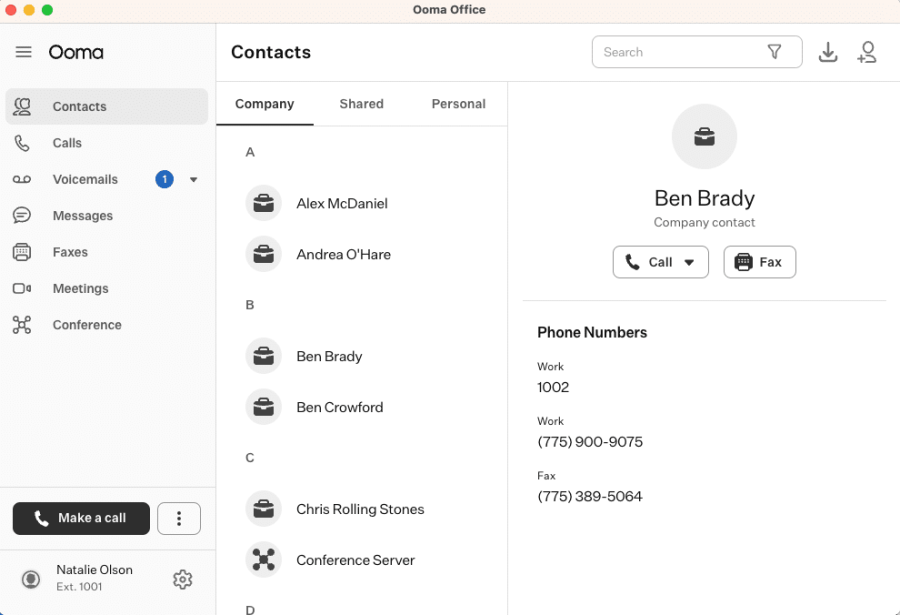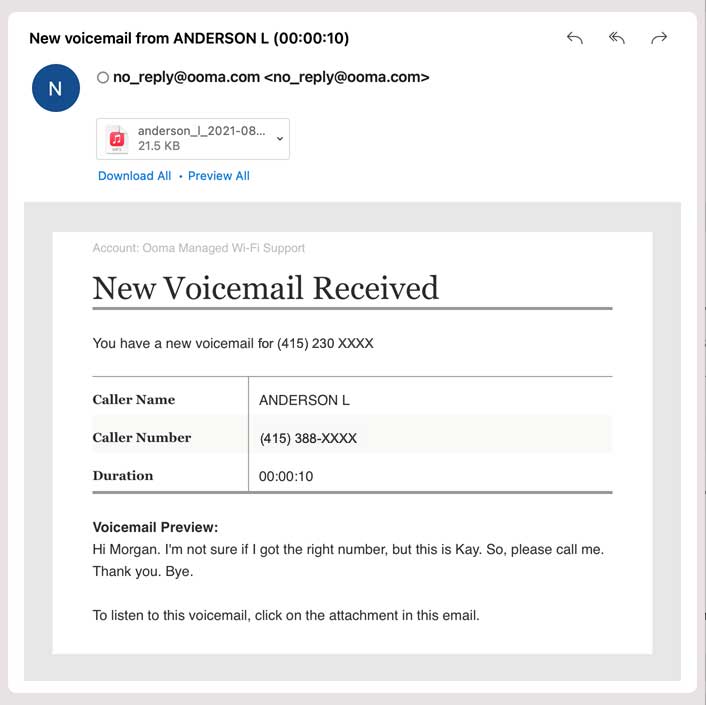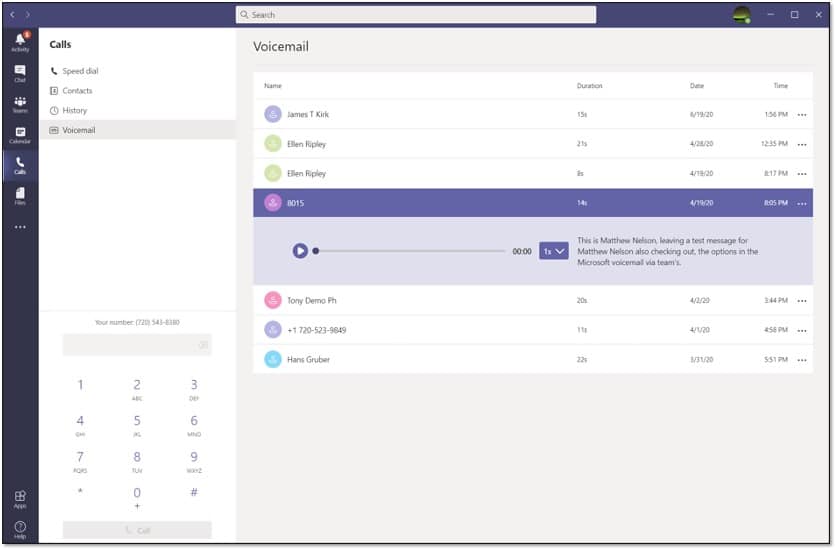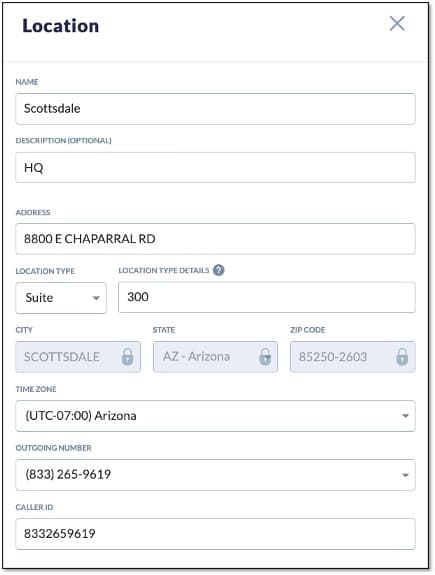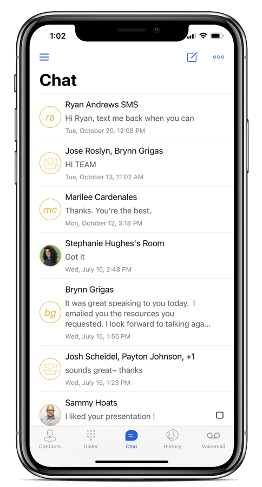VoIP vs Landline — Everything You Need to Know in 2024
Business communication systems are now central to every organization’s success, and knowing the difference between VoIP vs landline can help you make the right decisions for your team and support all of their communication needs.
The main difference between VoIP vs landline is that VoIP relies on the Internet to connect the caller to one or more call recipients, while landlines use physical wires known as the Public Switched Telephone Network or PSTN.
In this article, we’ll go over how VoIP differs from landlines in terms of costs, functionalities, and flexibility, and we’ll go over all the core business considerations. We’ll also cover the pros and cons of VoIP vs landlines and compare the best VoIP services on the market today.
-
-
The Key Difference Between VoIP and Landline
Desk phones and landlines were the traditional services used for business telephony since the 1900s, but with the explosive growth of mobile phones and the Internet, their usage began to decline in the 2000s.
Interestingly, it’s the Internet that would define the key characteristics of the VoIP vs landline debate. Hence, Voice over Internet Protocol, or VoIP, is a new kind of telephony that came to the forefront in the late 90s.
From the 2000s until the pandemic and the post-pandemic period, which necessitated remote communication at scale, VoIP has found its place as the most popular business communications system of our time.
Today, VoIP is widely used for Internet-based telephone calls, as well as data communications – e.g., softphone apps installed on a computer. Here’s a full overview of how VoIP compares to landlines.
What is VoIP and How Does it Work?
Voice over Internet Protocol (VoIP) is defined as a set of technologies and networking protocols that let you make voice calls using a broadband Internet connection instead of PSTN lines.VoIP works by converting the caller’s voice, which is an analog frequency, into digital data. This data can be sent across the Internet in real-time and received on the call recipient’s device, where the frequencies are converted back into a form that humans can understand.
This job of conversion is performed by programs called codecs (short for compression and decompression). Modern VoIP solutions like Ooma, Vonage, Nextiva, and others enable data communications via VoIP.
Ooma, for example, supports advanced codecs like G.722 and OPUS for clear audio and minimal call dropping.
It’s also worth noting that VoIP services can work via VoIP applications installed on computers and other devices, called softphone apps. Some are also compatible with traditional telephones, i.e., landlines, by working through a VoIP adapter.
What are Landlines and How Do They Work?
A landline is defined as a physical telephone connection that requires metal wires running from a fixed location to a public grid and from the grid to the call recipient’s location.A major difference in the case of landline vs VoIP is that the call signal remains in its original analog state as it’s transferred from the originating device to the network to the recipient’s device.
Landlines can work using a variety of wiring systems, such as the Plain Old Telephone Service or POTS networks comprising copper wires. Some landlines may even rely on fiber telephone wires to transfer the analog audio signal.
When you have a landline phone on business premises, it’ll be connected to the company’s Private Branch Exchange (PBX) system at the backend. The signal passes through the PBX, traveling across a network of wires and switches until it reaches the recipient’s premises.
Landline phones are identified using local area codes and extension numbers so that the signal knows which building it’s intended to reach and the specific device within that building.
As such, due to this fixed identification system, changing your landline number or adding a new one can be a time and effort-intensive process, but having these area codes does make them reliable in emergency situations.
VoIP vs Landlines Summary
As you can see from our above explanations, VoIP and landlines vary significantly in how they work. VoIP hinges on analog-to-digital data conversion and takes advantage of our extensive Internet infrastructure. Landlines enable analog audio signals to travel across dedicated metal wires from one fixed address to another.As such, VoIP solutions can work using any kind of Internet system, be it Multi-Protocol Label Switching (MPLS) lines, Software-Defined Networking (SDN), or Wi-Fi. For this reason, it’s a popular choice among businesses of all sizes, including home offices.
Beyond this, VoIP connections are possible in any location on any device that has an Internet connection, which is why VoIP is also easier and cheaper to set up than landlines.
In contrast, a landline relies on a physical connection, and both the caller and the call recipient’s telephones must be connected to PSTN, a large-scale physical grid typically maintained by governments and government agencies.
At its core, VoIP is a digital technology that’s untethered to the hardware it uses, while landlines are analog in nature.
The Pros and Cons of VoIP Services and Landlines
The pros and cons of VoIP vs landline are what will determine your decision to choose one over the other. One of the biggest advantages of landlines is that it was the first telephony technology to become widely accessible to consumers and business users alike.
But over time, the cons of landlines, like price and lack of flexibility, have outweighed the pros. In contrast, Voice over Internet Protocol or VoIP services have the upper hand in terms of the features on offer, ease of use, and accessibility. Let’s discuss these factors in more detail:
Key Pros and Cons of VoIP
Did you know that VoIP technology is now so popular that several countries are turning off their PSTN infrastructure altogether? For example, the Netherlands moved from PSTN-based landlines to VoIP in 2018.
The Australian Government announced its plans to switch off its PSTN services by 2023, and in the UK, BT intends to move on from PSTN networks by 2025. These decisions are fueled by a clear understanding of the pros and cons of VoIP and, indeed, its overwhelming advantages.
However, it does have a few disadvantages as well. Here’s an overview of the main pros and cons of VoIP that you need to know:
Pros
- Save costs: You don’t have to spend on acquiring and maintaining PBX hardware, and there are no wiring charges.
- Make calls flexibly: VoIP allows you to make calls from any location with an Internet connection.
- Port numbers easily: VoIP is based on the concept of a virtual phone number. If you open a new office or change devices, the number comes with you.
- Scale up or down freely: When call volumes increase, VoIP lets you add new numbers without having to obtain a dedicated line.
- Enjoy advanced features: You get features you won’t get with landlines, like auto-attendance and call transferring built-in.
- Improved call quality: Modern VoIP services like Ooma support crystal-clear voice calls. In contrast, landline call quality tends to drop over time.
- Enables data transfers: Since VoIP is Internet-based, it can transfer data alongside audio signals, so you can share documents and images while speaking.
- Call from any device: VoIP brings calling capabilities to any smart device, including laptops, desktops, tablets, and smartphones.
- Make secure calls: VoIPs offer a host of security measures, from firewalls at the network level to encrypting the audio signals.
- Integrate with business apps: VoIP services can fit seamlessly into your other business systems, like your Customer Relationship Management (CRM).
Cons
- Good Internet is required: If the underlying network isn’t reliable, then VoIP services will suffer. Ideally, you want a low-latency network environment.
- Compatibility issues: Dial-up internet or similar legacy networking systems aren’t suited to VoIP. You need fiber Internet or LTE/5G networks.
- Jitter: This occurs when a connection has inconsistent latency. Specialized VoIP routers, high-quality cables, and strong Internet can prevent jitter.
- Location Tracking: While ultra-portability is great, it makes it difficult to pinpoint the caller’s location, which is a problem in emergencies.
- Fax doesn’t work: When VoIP codecs compress an audio signal, they alter it, which makes it incompatible with older telecom systems like fax machines.
Key Pros and Cons of Landlines
Even though landlines are on their way out, many businesses and consumers still rely on these systems for the occasional call. In the UK alone, a survey conducted in 2021 found that 69.5% of businesses still use landlines.
In the US, over 40 million households own landlines, and more than half use them for 16 to 50+ calls a week. That’s because, despite its shortcomings, landlines do offer a handful of key advantages. Here are the pros and cons of landlines compared to VoIP:
Pros
- Make calls without an Internet connection: When there’s no Internet connection available, landlines will still work.
- Achieve greater reliability: Landlines are perceived as being more reliable, which is why older businesses and senior citizens sometimes prefer them.
- Eliminate call dropping: Landlines transfer audio signals without any compression or decompression, which enables zero dropped calls.
- Reach non-internet users: As of 2023, 64.6% of the global population uses the Internet, so over 1 in 3 either don’t have Internet access. Landlines offer a way to reach such users.
- Reach remote locations: Several regions are yet to have reliable broadband connections. Landline infrastructure is more widespread.
- Enables traceability: Landline numbers are attached to an address, so they’re useful for emergency services, where the call origin needs to be located.
- Enjoy added convenience: Due to the traceability factor, landlines have other uses apart from calling, such as acting as proof of address.
Cons
- It’s expensive: You have to pay for each dedicated line and number, the actual landline device, and changing numbers will incur further fees.
- Costs are linked to distance: International calls can attract a prohibitive fee, and call charges are also much harder to monitor than VoIP.
- The risk of spam calls is greater: Despite the Federal law forbidding calls using automatic dialers or prerecorded messages, landlines are at risk.
- It won’t integrate with business systems: They don’t natively integrate with your CRM, collaboration apps like Microsoft Teams, or other software.
- Field workers can’t use landlines: In industries like construction or utility services, employees don’t have access to landlines when they’re on the move.
- It isn’t suited to hybrid work: Landlines are fixed. Employees who work at home some days can’t keep using the same phone number.
- Automation is impossible: Automations like a virtual assistant who greets callers or an Interactive Voice Response (IVR) aren’t available on a landline.
- Difficult to scale: You’ll need to submit an application, provide documents, and get a full hardware infrastructure set up to install a single landline.
The Cost Comparison for Landline vs VoIP
One of the key differences between landlines vs VoIP is their cost component. On the surface, you may feel that they cost largely the same; a traditional landline service may start from $20 per month, whereas VoIP services start from $15-$20 and go up to $60 or more.
But if you unpack the costs further, you’ll find that there’s a gap between how much you’re billed monthly and your real expenses with a landline connection. In comparison, the costs of VoIP are predictable and depend on scale.
Monthly Expenses for VoIP and Landline Services
Leading VoIP providers such as Ooma, Vonage, Nextiva, Phone.com, MightyCall, RingCentral, and Grasshopper all cost between $12.74 and $20 per month. Among these, the cheapest VoIPs are ones that offer a limited number of minutes, whereas the more expensive ones come with extra features and unlimited calling.
When you opt for VoIP services, you’ll be billed per user account per month, and most VoIP providers allow more than one phone number per account. Compared to VoIP, landlines can be more expensive month on month, although there can be lower-priced options as well, depending on where you live.
For example, AT&T’s traditional home phone with a primary residential number costs $46 per month. Keep in mind that this includes unlimited local calling. The real difference between the monthly expenses for VoIP and landline services starts to show when you need more than one number.
A small business can get multiple numbers under the same VoIP account at a relatively low cost. In the case of landlines, you’ll need to multiply the monthly fee for each line by the total number of employees, and there are zero cost benefits as you scale.
Equipment and Installation Costs
VoIP installation costs vary depending on the type of hardware you want. Do you want a dedicated VoIP phone? Are you looking to integrate VoIP into your existing business apps? Or do you simply want to make VoIP calls from a smartphone or computer?
The costs of installing the service can range from $0 to $50 or more, but if you already have smart devices where you’d like to use VoIP, then you can save on hardware costs. That said, keep in mind that porting your existing numbers to a VoIP company will incur a fee of $20-30 (or thereabouts).
On the other hand, installing a landline is a complex process, where you may have to hire a skilled phone installer. This will cost between $50 and $80 per hour, depending on the location.
Expect to incur high hourly labor charges if you’re a small business or a medium-sized call center. Plus, the copper cable phone line itself is worth $100-300. The landline phone, on the other hand, will typically come bundled with the monthly fee.
To sum up, a VoIP setup can cost approximately $200 per line, starting from scratch (new Internet connection, new device, new VoIP account). In comparison, landlines will cost around $400 per line, and it won’t get any cheaper as you add more numbers.
Long-Distance and International Calling Charges
International calling charges on landlines are significantly higher than VoIP calls. For compassion, AT&T’s pay-per-use rate for calls to Australia from the US is $4 per minute. Ooma charges $0.038 per minute for the same service.
Keep in mind that you can get specialized plans for long-distance and international calling. These plans for landlines come with a discounted rate, whereas many VoIP service providers like RingCentral include unlimited calling plans.
Potential Savings With VoIP
The potential savings with VoIP vs landlines can be several thousands of dollars for a team of 10 employees or more. When choosing one over the other, keep the following factors in mind:
- For greenfield installations – a fresh setup in a new site – VoIP and landlines will cost nearly the same. The difference is that you can use and re-use the VoIP infrastructure for additional lines, while landline setup costs will multiply as you scale.
- Monthly fees for VoIP are lower than landlines and also more predictable. You can take advantage of the same VoIP company in different locations around the US. This leads to considerable savings.
- Landline devices are expensive, and they aren’t multi-purpose. You can use VoIP with your existing or new smart devices, and VoIP phones can serve other functions, such as help in video conferencing. The value you get from VoIP equipment is higher.
- VoIP technology is updated at regular intervals. Your vendor, along with your in-house IT team, will look after this process. While this is an added cost, VoIPs aren’t subject to physical wear and tear like landline copper cables.
- VoIP is cheaper for international calls by a wide margin. VoIP business services even offer virtual international numbers so that you can establish a credible presence in other countries while working remotely.
- The lack of integration with landlines can lead to lost opportunity costs. VoIP services can exchange data with apps like Salesforce and Microsoft Teams, making it easier to do business. Nextiva, for example, shows you a pop-up with customer info as soon as you receive a call.
Landline vs VoIP Functionality
Companies and countries aren’t switching off their landline connections only for cost reasons. The landline vs VoIP debate also has to do with functionality and the non-calling features you can expect from each.
Landlines are considered more reliable with zero risk of dropped calls. On the other hand, VoIP offers features like call transfers and forwarding for free. It also integrates with your other communication tools. Let us discuss these differences in detail.
Call Quality and Reliability Comparison
Which is more reliable, landlines or VoIP? The answer is more complex than you may think. VoIP is more reliable in locations with a strong Internet connection. You can receive a call from any device, even if you don’t have access to a fixed telephone.
Plus, since VoIP data packets are transmitted over the Internet, no one can intercept them. VoIP calls also offer excellent quality when you opt for a leading VoIP provider. Plus, the ability to share files while calling enhances your experience.
On the other hand, landline connections are more reliable in remote areas where high-speed broadband is difficult to come by. The issue of latency doesn’t arise as the audio signals are transmitted in their original analog form. However, old or low-quality wiring can lead to poor call quality.
Also, if you’re calling a fixed landline number, you can never be sure if you’ll reach the intended call recipient because, in a world of WFH and increased mobility, fixed desk-based working isn’t common.
In other words, VoIP services and landlines can be considered reliable in different scenarios and should be used accordingly.
Voicemail, Call Forwarding, and Other Features
One of the main advantages of VoIP systems is that they come with a host of value-added features that you couldn’t imagine in a traditional landline phone. Traditional services like voicemail or call forwarding are now better.
For example, you can get automated voicemail transcriptions and get an AI tool to analyze them for trends. Similarly, for call forwarding, you can set up different forwarding patterns so that no call is ever ignored.
VoIP also adds new features to the telephony experience like:
- Built-in call recordings
- Virtual receptionists
- Detailed call analytics
- Intelligent call queues
- Digital call deflection (to SMS or any other channel)
Integration With Other Communication Tools
As we mentioned, interoperability and the ability to connect to business apps are one of the main advantages of VoIP in the VoIP vs landline debate. Integration refers to the ability to exchange data between different applications – for example, between a CRM like Salesforce and a telephony service.
When you can move data from one system to another, you can also turn data flows into “events” that act as triggers for other actions. For example, a new customer being onboarded on Salesforce can be an event. When such an event occurs, it can automatically trigger an action, like sending a welcome SMS to the customer.
This is how integration makes way for the automation of business processes. The above is an example of how Nextiva integrates with Microsoft Teams, here are the 3 main ways that VoIP supports integration with communication and other business apps:
- WebRTC: An open-source protocol that lets browsers and mobile apps enable real-time communication through pieces of code called Application Programming Interfaces (APIs).
- Preconfigured APIs: Top VoIPs give you ready-to-use APIs for popular apps. Here, you don’t need to mess with code snippets, documentation, or WebRTC technology. All these backend components are packaged into VoIP add-ons called connectors, which you can download from the vendor’s marketplace.
- SIP: Session Initiation Protocol (SIP) is a technology that helps integrate VoIP with PSTN. This lets you access Internet-based VoIP services from a fixed, on-premise phone system.
Compared to VoIP, landlines don’t support any native integration with your apps. This is because the two systems are built on different technologies, so the only way to introduce integrations in a landline-based environment is by using VoIP adaptors.
Landline-Specific Features and Limitations
Despite the cons in terms of lack of value-added features and integrations, are there any specific capabilities that are unique to a landline? The answer is yes. There are a few reasons individuals and companies still hold onto their landline phones; the first is discoverability.
As landline numbers are fixed and trackable, you can choose to list them on the Yellow Pages or online. If someone has to reach you in an emergency or wants to look you up, landlines can be useful.
Another important feature of landline phones is emergency use. It allows 911 responders to quickly find your address directly from the call. Even if a person calls 911 and has to hang up in an emergency without sharing their address, the phone number makes it possible to find you faster.
It’ll also work during a power outage as it neither relies on a battery-operated device nor does it require an Internet connection. That said, as we move from landlines to VoIP services, the latter now also comes with emergency support.
The same capability in VoIP is called Enhanced 911 or E911. Here’s an example of this on Nextiva, which allows you to input your address and details for emergency services:
When you get a Voice over IP number, you also have to configure a fixed physical address that’ll show up whenever you make a call. Next Generation 911, or NG911, is an advanced version of this same idea.
It’s an IP-based system that lets you send texts, videos, and other data to emergency responders instead of only calling them. To sum up, discoverability and emergency use are two important landline-specific features, although VoIP technology is catching up fast. That said, landlines have several limitations, such as:
- Wear and tear of physical infrastructure
- Lack of portability
- Expensive and cumbersome wiring systems
- Declining support in several regions
Comparing the Flexibility of VoIP vs Landline
Another major factor that defines the VoIP vs landlines debate is flexibility. The whole point of getting a landline connection was to maintain a fixed, unchanging telephony address. In some cases, this would even act as a proof of residence.
The premise behind VoIP is exactly the opposite. You can take it with you wherever you go, the number remains the same even as you switch locations, and many devices can work with one VoIP connection. This gives you the flexibility to use VoIP calling services in a variety of situations:
Hybrid Working
More than 2 in 3 full-time US employees prefer a hybrid work schedule, working remotely for at least one day a week. This is different from 100% WFH, where you are entirely at home.
WFH employees can still communicate with their coworkers via fixed landlines. Hybrid workers, on the other hand, need more flexibility. Voice over Internet Protocol (VoIP) works seamlessly across your home phone, your laptop, and your desktop in the office.
Field Service Professionals
Like hybrid workers, field service professionals, too, don’t work out of a fixed desk. Social services, healthcare, construction, law enforcement, and several other jobs require people to constantly move from one place to another.
They require a flexible way of communicating, which landlines simply cannot provide. Some may choose cell phone connections as an alternative, but VoIP is cheaper and more feature-rich.
Scalable Work Environments
Industries that need to make a high volume of calls often choose VoIP because it allows them to quickly scale. For example, imagine a call center for a health insurance company that receives thousands of calls every day.
Landlines don’t provide the flexibility to quickly add new infrastructure, set up connections, onboard the user, and get them started with calls.
Jobs with Fluctuating Call Volumes
Another benefit of flexibility is that it not only lets you scale up but it also lets you scale down equally easily. Let’s say a major retailer is running a series of holiday shopping campaigns. Between November and December, the company will be inundated with calls.
But what happens when the holidays are over and call volumes drop? With landlines, you’d be left paying for all those fixed connections and copper cabling for months. In contrast, VoIP gives you the flexibility to commission and decommission new numbers as and when needed.
You always have the calling capacity you need but don’t have to pay for idle systems.
Senior Executives
CEOs of companies, board members, and other senior professionals rarely work out of a fixed desk. They may have to travel for work, attend meetings and events in different locations, give interviews, and fulfill other obligations.
All of this is centered around a high degree of mobility. While most senior executives will have a fixed landline for redundancy reasons, VoIP gives them the flexibility to make and receive calls wherever they need.
Not only this, but they can also make use of their downtime – e.g., in airports – to catch up on conversations. Since VoIP services also support data exchange, that’s an added layer of flexibility in their work day.
In addition to calls, they can send and receive documents, view files, etc., and choose their preferred pattern of productivity. To sum up, Voice over Internet Protocol (VoIP) has the upper hand when it comes to flexibility.
Companies choosing between VoIP vs landlines must account for their current and future flexibility requirements. Landlines are great for small, desk-based teams, but you need VoIP if you want to keep up with high demand, employee expectations for flexible work arrangements, and field-based work needs.
The Best VoIP Services to Consider in 2024
Given all the above considerations, let’s look at some of the leading VoIP providers today and the differentiated value they offer:
Top VoIP Providers Starting Price of Paid Plans Countries Supported Free Trial Money-Back Guarantee Top 3 Features Ooma $19.95/user/month 60+, including China, India, and Australia 2-month free trial 30-day guarantee for all hardware purchases – Multiple packages for homes and businesses
– UJET partnership to power cloud-based contact centers
– POTS replacement solutionsVonage $19.99/user/month 50+ including Tier 1 and Tier 2 country plans Undisclosed 30-day guarantee for the primary line – Programmable APIs
– Automatic speech recognition in 120+ languages
– Integration and add-on marketplaceNextiva $18.95/user/month 50+ countries with free calls in the US, Canada, and Puerto Rico 7-day free trial 30-day guarantee – Customer survey and live chat features
– “Call Pop” customer intelligence feature
– Conversational artificial intelligence (AI)Phone.com $12.74/user/month 50+ with US local rates to landline numbers in Canada, France, Germany, and the UK Undisclosed 30-day guarantee and volume discounts – HIPAA-compliant voice and video for healthcare providers
– My.Phone.com to access VoIP accounts anywhere
– AI-powered Answer Bot to route callersMightyCall $15 /user/month 60+ with dedicated lines for different regions 7-day free trial Undisclosed – AI for monitoring call quality
– 5-minute online setup process
– Unlimited minutes, SMS, and MMSRingCentral $20 /user/month 60+ with Global MVP and International Virtual Numbers (IVN) 14-day free trial 30-day guarantee for prepaid plans – Packaged solutions for business communications and customer experience
– Conversational AI and AI agent assistance
– Free video and messaging appGrasshopper $14/user/month 40+; international calling available to customers after 60 days 7-day free trial Undisclosed – Solutions for solopreneurs
– Unlimited users (limited phone numbers) available
– Instant response feature to avoid missed callsGiven that VoIP is a multi-billion dollar market, it can be difficult to choose the best VoIP service when you’re leveling up from your landlines. These 7 providers are among the best in the industry in terms of the rates they offer, feature set, and international coverage.
For a deeper look into these, we recommend reading our full review and comparison of the market’s best VoIP services.
Key Considerations for Businesses
Here are 7 key factors that’ll determine your decision to choose VoIP vs landline for your business:
- VoIP sets the stage for scalability and growth: Companies that want a scalable calling environment typically choose VoIP as you can grow by adding new numbers and connections with less effort and cost than landlines.
- Internet-based calling can integrate with other apps, unlike landlines: If your business already has a solid digital footprint – a collaboration app, a CRM, or HR software – VoIP can fit into your existing systems. Landlines don’t provide this option.
- VoIP can cost thousands of dollars less than landlines: The total cost of ownership or TCO is the money you end up spending on technology over time. Apart from initial costs, the TCO of landlines is very high, especially if your business needs to make international calls.
- Landlines fulfill a key redundancy need (for now): Redundancy in technology is like a Plan B; i.e., it’s there to take over if the primary system fails. A landline now serves this purpose for most businesses as it works during outages and in emergencies.
- Businesses with multiple locations will find VoIP more suitable: Many landline numbers across your multiple offices or stores or construction sites of any other location can be challenging to manage. VoIP, on the other hand, is designed for distributed working.
- Fast Internet is a must-have for VoIP: When choosing between VoIP and landline, businesses must first assess the kind of Internet connection they have. You may need to strengthen your network before making the switch from landlines to VoIP.
- VoIP requirements for emergency services need special attention: VoIP phones or devices need to be specially set up for emergency services. Whenever you take a new number, remember to configure the E911 first and update it at regular intervals.
Our Other VoIP and Business Communication Guides
If you want to learn more about modernizing business communications, feel free to check out our other VoIP guides:
- What is VoIP? The Definitive Guide to VoIP
- The Best VoIP Services Compared and Reviewed
- Cheapest VoIP Phone Service Providers for Business and Personal Use
- VoIP Security: The Ultimate Guide to Encryption and Vulnerabilities
- How to Choose a VoIP Provider (Beginner’s Guide)
- The Best Mobile VoIP App Solutions Reviewed
Conclusion
Voice over Internet Protocol (VoIP) is the next milestone in the evolution of telephony services. While landlines have remained unchanged for decades, VoIP has advanced in leaps and bounds.
The key difference between the two is that landlines use fixed copper cables and analog data, while VoIP uses the Internet to transfer audio signals after they’re converted into digital format. This basic difference gives rise to several advantages in the case of VoIP, from software integrations to portability and lower costs.
But this doesn’t mean that landlines are obsolete. In fact, individuals and businesses often opt for landline connections for discoverability, credibility, and reliability reasons. As such, you need to carefully assess your own requirements and expectations from telephony infrastructure to make the right call.
Alternatively, many choose to have both coexist in their communications environment. We highly recommend checking Ooma out — whether you’re after a residential or business VoIP solution.
VoIP Vs Landline FAQs
Is VoIP a landline?
Technically, VoIP is a service and not a device. Yes, you can use VoIP with a desk phone, known as an IP phone. You can also use it from your laptop or smartphone. Traditional landlines can also access VoIP services through VoIP adapters.
Is VoIP reliable?
Yes, VoIP is extremely reliable. Top VoIP providers offer 99.999% uptime and 24/7 support. However, VoIP calls may be patchy in regions with very slow Internet (e.g., dial-up connections).
Why VoIP is better than traditional phone services?
VoIP is better than traditional phone services because it offers much more than only phone calls. You can share files, take part in video conferences, and connect popular apps like Salesforce. VoIP is also cheaper than traditional phone services when implemented for multiple users.
Is VoIP reliable for business?
Yes, VoIP is reliable for business, which is why the Federal Communications Commission (FCC) has unanimously voted to turn off PSTN lines in favor of a nationwide IP network. VoIP lets businesses set up multiple offices, scale easily to hundreds of users, and integrate their business data. Companies can rely on VoIP to provide consistent experiences to their customers.
Should I keep my landline in case of an emergency?
You may choose to keep your landline in case of an emergency, but less than a quarter of Americans still own landlines, as reported by the Washington Post. If you’re switching to VoIP from landlines, you can avail of emergency services via E911.
Can VoIP call to regular phones?
Yes, VoIP can place calls to regular phones, including Plain Old Telephone Service (POTS) landlines and cell phones. It can also make international calls at lower rates.
References
- Americans Are Embracing Flexible Work—and They Want More of it [McKinsey & Company]
- Internet and Social Media Users in the World [Statista]
- United States Landline Insights Report For 2023 [CommunityPhone]
- Almost 70% of UK Businesses Still Use Landlines [HR News]
- Digital Telephone Switchover [House of Commons Library]
- Web Audio Codec Guide – Web Media Technologies [MDN]
Anwesha Roy Tech Writer
View all posts by Anwesha RoyAnwesha is a technology journalist and content marketer based out of India. She started her career in 2016, working for global MSPs on their thought leadership and social media before branching out in 2018 with her own team.
She writes on technology and its intersections with communication, customer experience, finance, and manufacturing and has her work published across a wide range of journals. In her downtime, she enjoys painting, cooking, and catching up with the latest in media and entertainment.
Anwesha has a Master’s degree in English literature from one of India’s top universities.
More VoIP Services GuidesView all
Latest News View all
Biden’s Manipulated Video Will Continue To Stay On Facebook; Oversight Board Confirms
A manipulated video of Joe Biden that was recently circulated on Facebook will not be taken down because it doesn’t violate Meta’s content policy, no matter how incoherent those policies...
Bitcoin Consolidates Around $43,000 as ETF Buzz Quiets Down – Will It Reach $100,000 After Halving?
The flagship cryptocurrency, Bitcoin, has been grappling with bearish pressure following the ETF-engineered rally in early January. However, despite the depressing short-term outlook, many believe BTC could hit $100,000 after...
REGULATION & HIGH RISK INVESTMENT WARNING: Trading Forex, CFDs and Cryptocurrencies is highly speculative, carries a level of risk and may not be suitable for all investors. You may lose some or all of your invested capital, therefore you should not speculate with capital that you cannot afford to lose. The content on this site should not be considered investment advice. Investing is speculative. When investing your capital is at risk. Please note that we do receive advertising fees for directing users to open an account with the brokers/advertisers and/or for driving traffic to the advertiser website.
Crypto promotions on this site do not comply with the UK Financial Promotions Regime and is not intended for UK consumers.
© Copyright 2024 Techreport. All Rights Reserved.
Scroll Up
